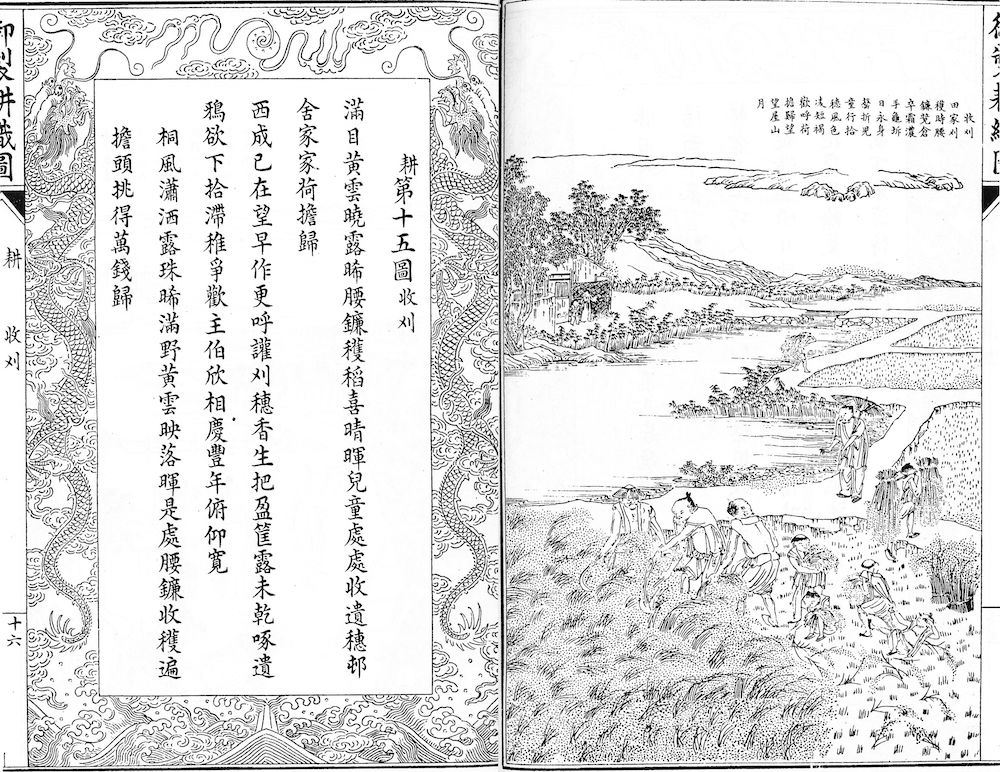Gengzhitu 耕織圖 "Drawings of tilling and weaving" is a book on agriculture and sericulture written by the Southern-Song-period 南宋 (1127-1279) scholar Lou Shou 樓璹 (1090-1162), courtesy name Shouyu 壽玉 or Guoqi 國器.
Lou hailed from Yinxian 鄞縣 in the prefecture of Mingzhou 明州 (modern Ningbo 寧波, Zhejiang) and occupied the office of magistrate (ling 令) of Qianxian 潜縣. In remembrance of the hard work the peasants and their families did, he compiled a book giving an overview over their activities. The 2-juan-long book was finished around 1132 and submitted to the throne. It was highly welcomed as a support to the court's attempts at promoting the output of agriculture. In later years Lou Shou was accounting officer in the Court of the Imperial Treasury (shenjisi 審計司), naval commissioner (boshi 舶使) of the region of Guang-Min 廣閩, grain transport commissioner (caoyunshi 漕運使) of Hubei, Hunan and Huaidong 淮東, and commander of the provincial army of Changsha.
The transmitted version of the Gengzhitu consists of illustrations and 45 descriptive five-syllable poems. It is China's oldest illustrated book that describes whole processes in agriculture and silk production. It is divided into the parts Gengtu 耕圖 "Pictures of ploughing" and Zhitu 織圖 "Pictures of Weaving". The first part consists of 21 illustrations, the second part of 24 images.
 |
Fifteenth figure of the ploughing section. 1886 Shanghai Dianzhizhai 點石齋 edition. |
The illustrations do not only show actions, but also a large inventory of agricultural tools that were in used in the lower Yangtze region during the Song period 宋 (960-1279). Some of these are of special interest, like the "sowing horse" (yangma 秧馬), or the use of stone rollers (liudu 碌碡) to level fields. The illustrated character of the Gengzhitu provided a paradigm for many later books specialized in technical fields, agriculture or astronomy, like Wang Zheng's 王禎 (1271-1333) Nongshu 農書, the Tiangong kaiwu 天工開物, the Nongzheng quanshu 農政全書 or the Shoushi tongkao 授時通考. While the illustrations served to "describe all circumstances" (tuhui yi jin qi zhuang 圖繪以盡其狀), the poems served to "describe their emotional effects" (shige yi jin qi qing 詩歌以盡其情), namely those of hard labour, and how to make it easier with the help of various machines and implements.
The Gengzhitu was first printed by Lou Shou's grandsons Lou Hong 樓洪 and Lou Shen 樓深. Apart from the Lou Shou's Gengzhitu, a book with the similar title was written by Liu Songnian 劉松年 (fl. 1225) during the Southern Song period, and by Cheng Qi 程棨 (1372-1432) during the early Ming period 明 (1368-1644). Yet these two books are more or less copies of Liu Shou's masterwork. Song Zonglu 宋宗魯 reprinted the Gengzhitu in 1462, but of his version, only some fragments have survived. An imitation and reorganization of the Gengzhitu can also be found in the book Bianmin tuzuan 便民圖纂 from the Wanli reign-period 萬曆 (1573-1619). The poems were in this version rewritten as so-called "Bamboo-twig songs" (zhuzhi ci 竹枝詞).
During the Qing period 清 (1644-1911) the Kangxi Emperor 康熙帝 (1662-1722) ordered Jiao Bingzhen 焦秉貞 (fl. 1689–1726) to revise the Gengzhitu to a high-quality edition that it might be distributed in the empire. The same happened during the Yongzheng 雍正 (1723-1735) and Qianlong reign-periods 乾隆 (1736-1795), but of the many Qing-period versions not many have survived. The Kangxi version from 1696 is transmitted with the title of Yuzhi gengzhi tu 御制耕織圖 because the seven-syllable poems of this version were "made by the Emperor" (yuzhi 御制). It differs from the original Song-period version in the titles of illustrations (Caisang 採桑, Yangcan 養蠶, Shangcu 上簇, Zejian 擇繭, Gaojian {宀/告}繭, Saosi 繅絲, Luosi 絡絲, Juanwei 卷緯, Zhengjing 整經, Zhiji 織機, Fanhua 攀華 (or Tihua 提花) and Ranse 染色). Three drawings have been omitted (Xiacan 下蠶, Weican 喂蠶, Yimin 一眠), but Jiao Bingzhen added two pictures of dyeing (Ranse) and finishing clothes (Chengyi 成衣).
Cheng Qi's version served as the blueprint for the Qianlong edition. The pictures were revised by the painter Jiang Bo 蔣溥 (1708-1761). This single copy was stored in the Guiji Shantang Library 貴積山堂 of the Yuanming Garden 圓明園. In 1769 the Qianlong Emperor added his own poems for this edition that was from then on stored in the Jiaxuan Hall 稼軒. When the British and French sacked the Yuanming Palace in 1860 the book went lost. It might be that it is the version owned by the Freer Gallery of Art. Another Qianlong edition is owned by the Historical Museum of China (Zhongguo LIshi Bowuguan 中國歷史博物館). The problem of such revisions is that the illustrations show tools from the Qing period and not those from the Song. The drawings were also created with modern techniques, and so substantially altered the original version of Lou Shou. The Gengzhitu was also reproduced on private initiative by Jin Tan 金檀 (Wenrui Studio 文瑞樓) and the Dianshizhai Press 點石齋 in Shanghai.
The Gengzhitu is included in the series Zhibuzuzhai congshu 知不足齋叢書, Longwei mishu 龍威秘書, Yiyuan junhua 藝苑捃華, Jiayongxuan congshu 嘉詠軒叢書 and Congshu jicheng 叢書集成. In most of these it is known under the title Yuqian ling Lou Gong jin gengzhi ertu shi 於潛令樓公進耕織二圖詩. The Gengzhitu also found reception in Korea and Japan.